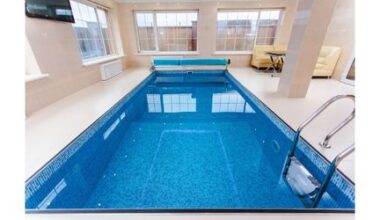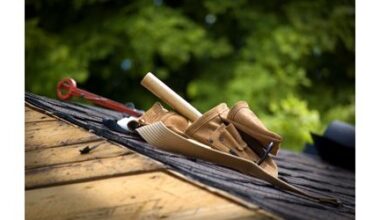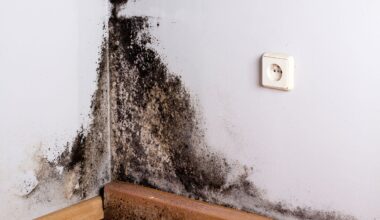How much does a pool liner replacement cost? This depends on a number of factors. The cost of the replacement of a vinyl inground pool liner differs from that of an above-ground swimming pool liner. We’ll discuss the other factors that affect the cost of a pool liner replacement in this guide, so you can choose which works best for you.
How Much Does A Pool Liner Replacement Cost?
The cost of a pool liner replacement ranges from $1,000 to $5,000, with the national average being $2,327.
Pool liners are an essential component of above-ground and inground pools that aren’t built of waterproof materials like fiberglass, concrete, or gunite. A liner keeps the water in the pool and keeps mold and mildew at bay. With age, a pool liner can bulge and break, resulting in leaks. Pool liner replacement can cost between $1,000 and $5,000, according to Angi and HomeAdvisor, with consumers spending an average of $2,327. A simple patch for a pool liner can cost as little as $350, while a full replacement can cost up to $5,000. Pool liners are often composed of vinyl, but fiberglass liners are another alternative, but they are more difficult to replicate. Pool liner replacement costs are influenced by several factors, including whether the pool is above-ground or in-ground, the size of the pool, and the thickness of the pool liner material.
Factors That Affect The Cost Of Pool Liner Replacement
#1. Pool Design
When considering the cost of a pool liner replacement, keep in mind that the price differences between above-ground and in-ground pools might be significant. The materials for an above-ground pool liner range from $100 to $600, plus $250 to $800 for installation. Materials for inground pool liners range from $700 to $1,500, with installation expenses ranging from $1,000 to $2,500. These rates can vary depending on the thickness of the liner as well as the size and shape of the pool.
#2. Pool Dimensions and Shape
Replacing a liner in a larger pool will be more expensive than in a smaller pool. Pool liner replacement prices are typically lower for pools with regular oval or rectangular shapes as opposed to kidney-shaped or L-shaped pools.
#3. Liner type
Above-ground vinyl pool liners are often classified into three types:
- Overlap liners: These are typically the least priced liner choice and the simplest to install. This sort of liner is thrown over the entire pool and secured using clamps. Overlap liners are rarely as durable as other liner alternatives.
- Unibead liners: This adaptable liner choice offers a smooth appearance. It clips to the top of the pool wall with a J-hook.
- Liners with beads These liners have a groove along the top of the pool wall that will snap into a track. These liners are thought to be simple to replace and repair.
#4. Liner thickness and design
Mils are used to measure pool liners. A mil is not a millimeter, as the name might imply; one mil equals one-thousandth of an inch. A normal pool liner is 20 mils thick and lasts 10 to 12 years. For pools that get a lot of use, a 28-mil-thick pool liner is recommended. A thicker liner will cost $300 to $400 more than a thinner choice, but it will last far longer. A thicker pool liner is less likely to shred or puncture and can help conceal an uneven pool surface. The cost of replacing a vinyl pool liner is also directly determined by the design of the liner. A liner with a solid color is usually less expensive than one with a patterned design. Darker hues are often more difficult and expensive to fix.
#5. Labor
Some pool companies may provide an estimate that includes labor and material costs as well as the total replacement cost. If they charge separately for labor, it can range from $30 to $50 per hour. The average labor cost to replace an inground pool liner is $1,000 to $2,500, whereas the labor cost to install an above-ground pool liner is $250 to $800.
#6. Refilling and Draining
To replace a pool liner, the pool must first be drained. A professional pool drain can cost between $500 and $700. If city water is utilized to refill the pool, the cost can range between $60 and $120 on average.
#7. Geographical Area
The geographic area is another key aspect that influences the cost of replacing vinyl pool liners. The cost of the liner, materials, and labor are typically higher in densely populated urban or suburban areas than in more rural ones.
#8. Season
Pool pros are busiest throughout the spring and summer months, and they may charge a premium for their services during those months. During the busiest months, homeowners may also expect to wait longer for pool liner replacement. Pool experts may charge much less during their sluggish months in order to gain more business.
Additional Fees and Factors to Consider
When planning for pool liner replacement prices, it’s critical to be aware of any additional expenditures and factors that may influence the entire price. These can include whether or not the pool liner has to be replaced or if a repair will suffice.
Replacement vs. Repair
The cost of hiring a professional to repair a vinyl pool liner varies according to the degree of damage, pool type, materials, and labor. The average cost of repairs ranges from $100 to $350, with more extensive repairs costing up to $1,700. For basic repairs, homeowners can use DIY patch kits, which range in price from $20 to $50. Some pool liners can be fixed as opposed to replaced. The following are some of the most typical pool liner repairs and their average costs.
- Leaks. A repair can cost up to $2,500 depending on the severity of the leak. Many homeowners will choose to replace the liner if the repair cost is that high.
- Tears, snags, and holes are common. Patching holes might cost between $100 and $500.
- Wrinkles. Pool liner wrinkles are prevalent as a result of defective installation, severe temperatures, poor chemical balance, or a sudden drop in water level. Repairing wrinkles can cost between $100 and $250, but if they’re severe enough, the lining may need to be replaced.
- Sun exposure. UV radiation and temperatures above 80 degrees Fahrenheit can harm a pool liner. Cover the pool during the day when it is not in use to protect it from sun damage. Repairing sun damage above the waterline can cost around $530 every 150 feet.
- Bulges. Groundwater freeze-thaw cycles and subflooring movements in the winter can generate bulges in the pool liner. Pumping out the water from behind the bulge or draining the pool and cutting out the bulged piece of the liner are two alternatives for repairing a liner bulge. You may need a liner replacement if the bulge is severe.
Types of Pool Liners
The cost of replacing above-ground and inground pool liners is affected by the type of liner used as well as the type of pool.
Vinyl
An above-ground vinyl pool liner replacement can cost between $350 and $1400, for both the materials and installation. A vinyl liner replacement for an inground pool can cost $700 to $1,500 in materials and an extra $1,000 to $2,500 in installation.
Fiberglass
Fiberglass is a long-lasting, sturdy alternative to vinyl pool liners that resists mold and mildew growth. A fiberglass liner might cost between $1,400 and $4,800 depending on the form and size of the pool. Minor repairs to a fiberglass liner can cost around $650.
Do I Need to Replace My Pool Liner?
Pool liners normally have a lifespan of 5 to 10 years, with some lasting up to 20 years, depending on usage and upkeep. A repair is sometimes the greatest option to extend the life of the liner, but there are clear signals that a liner has to be replaced. If homeowners discover any of the following problems with their pool liner, it’s likely that a new liner is required. Delay in replacing a pool liner can result in costly pool floor and wall damage, as well as deck deterioration from water erosion.
#1. Leaking pools
Minor leaks are usually repairable, but major leaks can damage the pool flooring and cause it to break. A cracked subfloor will have to be replaced. Leaks can also cause the metal walls to rust, compromising the pool’s structural stability.
#2. A liner that is dry or brittle
A pool liner can become brittle and split as it ages. Newer liners can be easily mended, but if the material becomes dry and weak, restoration becomes difficult and a new liner is the only alternative.
#3. Large tears or holes
Larger tears or holes in soft vinyl are more difficult to patch than smaller ones. If the hole is too large to be repaired, the pool liner must be replaced entirely.
#4. Chemical Impairment
The improper chemical pH in the water might cause the pool liner to wrinkle and break down more quickly than typical, necessitating liner replacement sooner than intended.
#5. Discoloration or staining
When a pool liner is exposed to harmful UV rays and the pool chemicals are not correctly balanced, staining or discoloration occurs. Algae development and rust can also discolor and taint the liner, making removal difficult. When this occurs, some homeowners choose to replace the liner for purely cosmetic reasons.
#6. Shape Change
As a pool liner ages, it can stretch and lose its shape. When the liner stretches out, it can cause bumps, wrinkles, and the liner to pop off of its track. If the liner continues to slip off of its track, water might leak behind it, causing problems with the pool’s structure.
#7. Inadequate Installation
An incorrectly fitted pool liner can wrinkle or ruin the bead tracks. If the liner is not properly positioned against the floor and walls, it might rip and cause considerable damage.
How to Cut Pool Liner Replacement Costs
Pool liner repair expenses can be difficult to budget for, and the additional fees involved with the project can soon mount up. Here are a few ideas for saving money without sacrificing quality.
- Obtain many quotations. Get at least three quotations from local pool professionals who are reputable.
- Select a simple liner. A patterned or deep-colored liner is substantially more expensive than a conventional sky-blue liner.
- Be adaptable. Pool service providers are busy in the spring and early summer. You may be able to save money if you schedule a pool liner replacement during their down season.
- Take the initiative. When not in use, cover the pool, keep the chemical levels adjusted, and patch small tears as soon as possible. Regular maintenance can help to avoid major issues.
- Purchase a high-quality liner. While it will cost more in the beginning, a high-quality liner will last longer and be more resistant to tears.
- Create a regular cleaning schedule. Cleaning the pool and removing the trash on a regular basis to eliminate sunscreen residue and algae accumulation can help to extend the life of the pool liner.
How frequently Should you Replace Your Pool Liner?
Inground vinyl liner pool owners should replace their liners every 5-9 years on average. The longevity of your pool’s liner is also heavily influenced by how well the pool is maintained, so some will need to replace their liner sooner, while others can go a little longer.
Rips and tears can be repaired without replacing the entire liner, however, some damage is too severe and requires more than a patch. Using harsh chemicals or failing to properly manage your pool’s chemistry can also weaken and diminish the liner’s lifespan.
If you have installed or are going to install a vinyl liner pool, keep in mind that changing your liner over a 20-year period will cost you an additional $9,000 to $18,000.
Is Replacing A Pool Liner Easy?
Installing a pool liner in an above-ground pool can appear to be a significant undertaking. However, if broken down into smaller phases, it is doable in a single day. Collaborate with a partner to make this project easier and more efficient. Make sure you choose the right size liner for your pool.
Can A Pool Liner Last 20 Years?
A vinyl liner has an average lifespan of 15-20 years, and where your liner falls in that range is determined, most importantly, by your correct pool chemistry upkeep.
In Conclusion,
The cost of replacement of a pool liner depends on whether it’s an inground or above-ground swimming pool liner, among other factors. The typical cost for a vinyl inground swimming pool liner replacement ranges between $2000 and $5,000. On the other hand, the cost for a vinyl above-ground pool liner replacement can range from $350 to $1500.
So there you have it, buying a swimming pool liner should not be a tough task. We hope this post clarifies things for you and answers any questions or concerns you may have.
Frequently Asked Questions
How long does it take to replace a pool liner?
Most pool liners may be replaced in 1-4 days after the new liner arrives, depending on the weather.
How do you know your pool liner is bad?
These are the signs that show your pool liner is bad:
- Cracks and Rips.
- Fading or Staining.
- Stretching and Wrinkles
- Water Leaks.
What happens if water gets behind the pool liner?
The water causes the liner to lose its initial seal, resulting in soft patches, wrinkles, and other flaws that result in a floating liner.
How often should pool liner be replaced?
A typical liner lasts 10–15 years, meaning you should replace your liner within that timeframe.
Can you put a new liner over an old one?
When changing an above-ground pool liner, we do not advocate leaving the old liner in the pool. It may appear to be an extra layer of security, but in reality, it will cause you more trouble.
Related Articles
- HOW MUCH DO CONSTRUCTION WORKERS MAKE (2023): Average Salaries Updated!
- MOLD IN APARTMENT: How To Test For Molds In Apartments
- How To Get Insurance To Pay For Roof Replacement
- PLUNGE POOL COST: How Much Does a Plunge Cost (Costs Breakdown)






